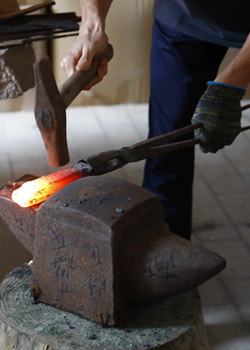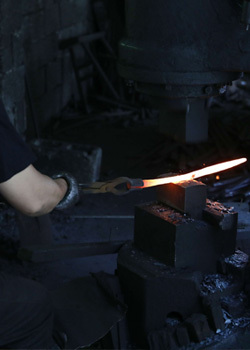
"After visiting a sword making facility in China’s Longquan Mountain range, we chose their experienced craftsmen to create our Bushido and Shogun lines of hand-made Katanas.We asked them if they could give us the background of this sword-making region, and they wrote us this rich history we thought you’d like to read (the English isn’t perfect, but we like the quirky nature of the translation and present it unedited)."
Read MoreKatanas
Shogun Ryū Tatsu Katana
The dragon themed tsuba and collar are exquisitely rendered; in ancient Japanese mythology dragons were associated with rainfall and bodies of water, and some could fly.
Click for MoreShogun Kiji Katana
The tsuba and pommel feature the Pheasant, the ancient Japanese symbol of harmony and the national bird of modern Japan. The tsuba, pommel and the fuchigashira (the collar next to the tsuba) are made of brass and given an aged finish.
Click for MoreShogun Tsuru Katana
The tsuba, collar and pommel feature the Crane, the ancient Japanese symbol of good fortune, longevity (Japanese mythology claimed the the Crane lived for a thousand years) and peace. Each is made of brass and given an aged finish.
Click for MoreBushido Tonbo Katana
The grip is genuine Rayskin wrapped with cord, and the wood scabbard has a striking flat, mottled copper colored finish with an equally striking black and tan cord wrap. Includes cotton storage bag.
Click for MoreBushido Kiku No Gyokuza Katana
The grip is genuine Rayskin wrapped with cord, and the wood scabbard has an attractive deep burgundy finish with glossy black “paint splatters” and a handsome black and burgundy cord wrap. Includes cotton storage bag.
Click for MoreBushido Nami Katana
The grip is genuine Rayskin wrapped with cord, and the wood scabbard has a flat black finish flecked with a gold sand pattern. Includes cotton storage bag.
Click for MoreMaking of Shogun and Bushido Katana swords
Experienced master craftsmen perform each stage of the creation of these swords.
Swords in Action
In the Tang Dynasty, the literati were more poetic about the Longquan sword. Li Bai has the phrase "Ning knows the grass, but there is a Longquan under his waist", which shows that the soldiers and civil warriors in the prosperous Tang Dynasty generally admired the Longquan sword.”
1
2
3


 Gift Cards
Gift Cards











